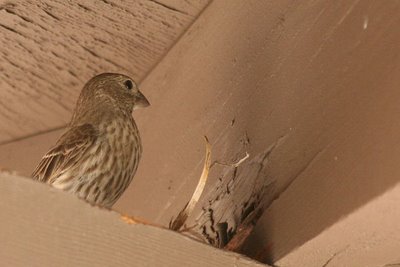On Saturday, two House Finches began building a nest in the corner of the porch outside my study. I watched them as they brought budding creosote sprigs and laid them on the beam. Later they switched to mesquite and dried grasses. The nest site is in a deeply shaded corner and I can't see it from the ground, although I can occasionally see pieces of nesting material sticking up.
On Saturday, I saw the male bring in quite a bit of nest material. He's a handsome fellow with vivid red colouring. Here, he's resting in a nearby mesquite tree after his hard work.
The red or yellow color of a male House Finch comes from pigments that it gets in its food during molt. The more pigment in the food, the redder the male. Females prefer to mate with the reddest male they can find, perhaps assuring that they get a capable male who can find enough food to feed the nestlings.On Sunday, I was able to get some photos of the female after she brought material to the nest site.
 Female House Finch bringing material to nest
Female House Finch bringing material to nestCanon Rebel XT, Aperture Priority, 300 mm., F/6.3, 1/100, ISO 400
According to the Cornell Lab's web page, the House Finch's nest is "an open cup of fine grass stems, leaves, rootlets, thin twigs, string, wool, and feathers, lined with similar but finer material." Eggs are "Pale blue with fine dark speckling, usually around larger end." Clutch size is 1-6 eggs.
I've just seen some of the new nest material blow off the narrow beam. I wonder if these finches will be successful in building a secure nest here.


6 comments:
I will occasionally see a yellow-orange variant male in my Tucson yard.
House Finches have never nested in my yard (at least as far as I know), but they are common at my finch feeders. They have apparently decided that something isn't quite right about my yard for nesting.
We have purple finches here - they just arrived in the past few days but there is quite a flock visiting at the moment.
I really enjoy their early morning songs.
I hope that nest is secure enough for them. They do put out so much energy to get it built. Lovely photographs of them, pam. They are such sweet little birds. We have two house finch nests in two trees in our front yard. We watch the activity when we're in our front office. We have the yellow-orange male variant, as well.
I see those beautiful house finches at my place too. I did not know that they got their pigment from food... which type of food? My husband thinks that the females are cool with their racing stripes. :-)
Beth and rd - I see the yellow-orange variant male around here, too. I don't think the finches are going to nest there. It doesn't seem to be a place where they could anchor a nest - just a smooth beam - and some of it blew away. I didn't see any sign of them today.
endment - I looked up the Purple Finch. They seem to be quite similar - although more generally rosier. Cornell says they've declined, possibly because they lose out to the House Finch in aggressive interactions.
cathy - I'll leave out some bits of my weaving yarns, just in case any of them do decide to return or nest nearby.
cynthia - According to Cornell's About Birds: House Finch they eat buds, seeds and fruits and like to frequent bird feeders.
keep us posted on this pair! I used to have finches -- actually in the house. Love their song.
Post a Comment